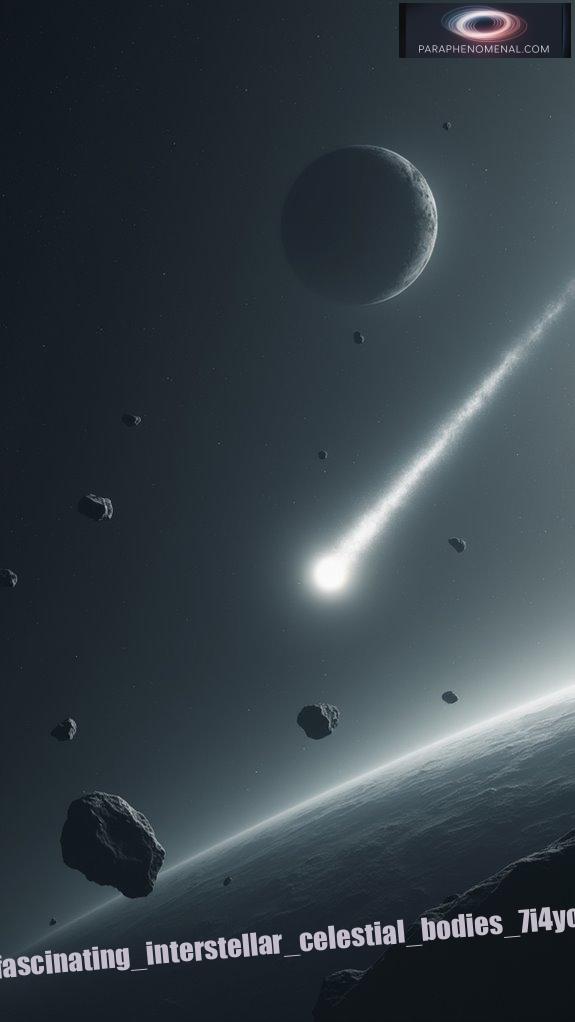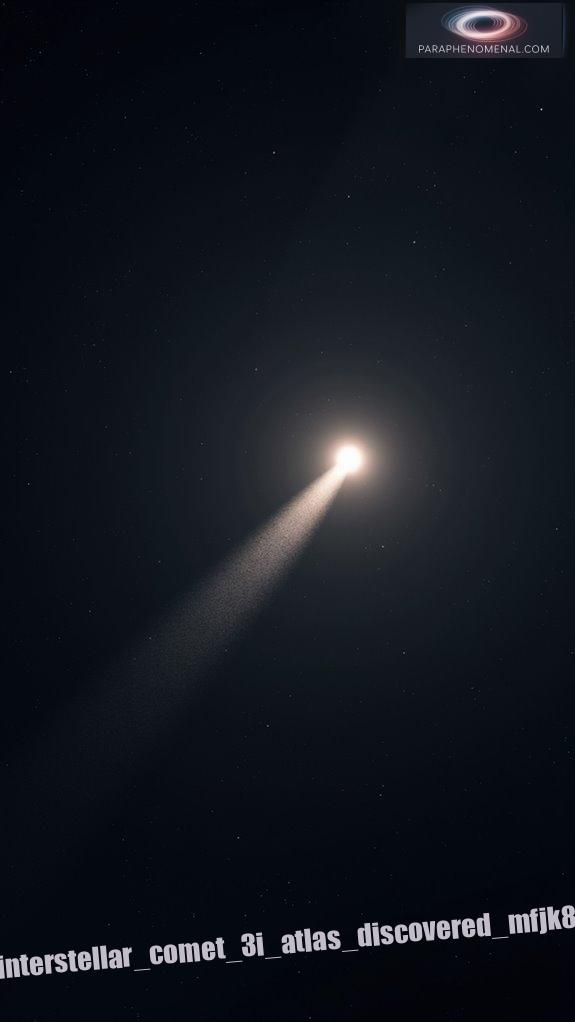Have you ever gazed at the night sky and wondered what else is out there?
Interstellar objects, like the intriguing 1I/ʻOumuamua, first visited us in 2017. Its elongated, cigar-like shape traveled cosmos for a staggering 600,000 years!
Then there’s 2I/Borisov, a comet brimming with carbon monoxide discovered in 2019.
The recently identified 3I/ATLAS, found in 2025, confirms its cosmic origins. Each of these celestial wanderers follows a hyperbolic path, whispering secrets of their extraterrestrial beginnings.
What else awaits our discovery in the vastness of the universe?
My Close Encounter with Interstellar Curiosity: A Journey into the Unknown
Last summer, I found myself stargazing atop a hill far from city lights, hoping to witness a dazzling meteor shower. Instead, I stumbled upon something unexpected.
It was late, and the sky glowed with stars. Suddenly, a shifting light darted across the constellation of Orion. I felt a thrill run through me. Was this a UFO?
The experience reignited my curiosity about interstellar objects. Could this be one of those intergalactic visitors? I dug deeper into the stories of ‘Oumuamua, Borisov, and other cosmic wonders. Each encounter made me ponder—what mysteries still lie beyond our understanding?
Quick Takeaways
- Interstellar objects are unbound bodies from other star systems, traveling through space on hyperbolic trajectories that escape the Sun’s gravity.
- 1I/ʻOumuamua, discovered in 2017, is the first confirmed interstellar object, characterized by its unique shape and nitrogen ice-rich surface.
- 2I/Borisov, detected in 2019, is a distant comet with a large nucleus that displays high carbon monoxide levels and signs of fragmentation.
- 3I/ATLAS, found in 2025, confirms interstellar origin through its hyperbolic trajectory, previously misclassified as a Near-Earth Object.
- Interstellar objects often exhibit complex compositions, high speeds around 58 km/s, and unique outgassing behaviors during their solar encounters.
Overview of Interstellar Objects

Interstellar objects are fascinating astronomical bodies that travel through the vast reaches of space, unbound to any particular star. These objects come from diverse interstellar origins, having likely formed in other star systems before experiencing dynamic interactions that ejected them into the void. They include various types, like asteroids, comets, and even rogue planets, each providing a unique glimpse into the cosmos. Unlike solar system objects, interstellar visitors follow hyperbolic trajectories, indicating their high speeds are sufficient to escape the Sun’s gravity. Current models predict that far more comets are ejected into interstellar space than are retained in the Oort cloud. Notably, objects like Comet 3i/Atlas have unusual trajectories that raise intriguing questions about their origins. Understanding these intriguing entities not only expands your knowledge of our universe but also fuels curiosity about what lies beyond. ParaPhenomenal seeks to illuminate these wonders, enabling your journey into the mysteries of space.
1I/ʻOumuamua: The First Visitor
The first confirmed interstellar object to pass through our Solar System, ʻOumuamua, captivated astronomers and the public alike since its discovery on October 19, 2017. With a hyperbolic trajectory indicating its interstellar origins, this unique object raised many questions.
| Characteristic | Detail |
|---|---|
| Shape | Cigar-like or pancake |
| Size | 100 – 145 meters |
| Rotation Period | 7.3 hours |
| Surface Composition | Nitrogen-rich ice |
Its unusual shape and non-gravitational acceleration, defying explanation within standard models, made it a thrilling subject of study. Recent analysis has suggested that its extensive journey likely took approximately 600,000 years to reach the Solar System from Vega, increasing interest in its origins. You can explore more about fascinating objects like ʻOumuamua on websites such as ParaPhenomenal, dedicated to unraveling these cosmic mysteries.
2i/Borisov: the Comet From Afar
A remarkable discovery unfolded on August 30, 2019, when amateur astronomer Gennadiy Borisov spotted a comet-like object moving through our Solar System, later confirmed as the second known interstellar visitor.
The Borisov observations reveal fascinating details about this interstellar comet.
Its characteristics can be summarized as follows:
- Estimated nucleus diameter of about 975 meters (3,200 feet).
- High levels of carbon monoxide in its comet composition, unlike typical Solar System comets.
- Fragmentation, indicating activity while passing through the Solar System.
- Trajectory confirming its escape from a distant star system.
Additionally, analysis of the coma displayed by Borisov suggests a diverse composition similar to other interstellar comets, which enhances our understanding of the types of materials present in such objects.
Borisov’s journey offers unique perspectives into celestial phenomena, enhancing our understanding of the cosmos, which is why we created ParaPhenomenal.
It’s all about exploring wonders like these.
3I/ATLAS: The Latest Discovery

Discovered on July 1, 2025, the object now known as 3I/ATLAS has captivated astronomers since its initial detection by NASA’s asteroid defense ATLAS survey in Chile.
The 3I/ATLAS discovery marked a significant moment in the field of orbital mechanics, as its hyperbolic trajectory confirmed its interstellar origin. Early calculations initially flagged it as a Near-Earth Object, but the analysis swiftly clarified its distinction.
The hyperbolic trajectory of 3I/ATLAS confirms its interstellar origin, distinguishing it from Near-Earth Objects.
The naming conventions reflect its classification as the third interstellar object, joining a select group of celestial travelers.
Observation challenges arose due to its faint magnitude and background star density, yet ongoing efforts reveal its intriguing physical properties. This object’s unusual solar path highlights the significance of hyperbolic trajectory characteristics in understanding interstellar comets.
This discovery not only enriches our cosmic understanding but emphasizes the importance of platforms like ParaPhenomenal in sharing knowledge.
Characteristics and Behavior of Interstellar Objects
Observations of interstellar objects, like 3I/ATLAS, provide understanding into their unique characteristics and behavior.
Here’s what you should know:
- Surface Composition: These objects often showcase complex carbonaceous compounds, lacking typical cometary volatiles.
- Dynamical Evolution: Their orbits are hyperbolic, indicating an extrasolar origin, and they can exhibit speeds around 58 km/s.
- Outgassing Mechanisms: Sublimation and chemical changes in ice can result in gaseous comae, affecting brightness and trajectory.
- Physical Structure: They display varying rotation states and physical shapes, ranging from elongated to irregular, complicating detailed analysis.
- Unusual Velocity: The interstellar speed of such comets can be significantly higher than typical solar system objects, as demonstrated by 3I/ATLAS.
The Population of Interstellar Objects in Our Solar System
While interstellar objects may seem like mysterious visitors from afar, they’re actually becoming a fascinating area of study in our Solar System.
Currently, there are three confirmed interstellar objects: 1I/ʻOumuamua, 2I/Borisov, and 3I/ATLAS. These objects display unique traits and highlight the challenges astronomers face in population estimation.
| Object | Discovery Year | Notable Characteristic |
|---|---|---|
| 1I/ʻOumuamua | 2017 | Elongated shape, no cometary tail |
| 2I/Borisov | 2019 | Comet-like, nucleus fragmentation |
| 3I/ATLAS | 2025 | High eccentricity, fast velocity |
Advancements in interstellar detection technologies and astronomical survey coordination will enhance future exploration plans. As velocity measurement techniques improve, understanding these objects’ interstellar origins will become more clear.
FAQ
How Are Interstellar Objects Detected From Earth?
Interstellar objects are detected from Earth using advanced detection methods that include automated survey telescopes and observational techniques.
These telescopes capture images of the sky, while software analyzes moving objects for unusual trajectories, indicating they might be from outside our Solar System.
Spectroscopy and astrometry further characterize their properties. Machine learning enhances the classification process, making it easier to identify these enigmatic visitors.
This intrigue makes understanding them essential for our cosmic knowledge.
What Tools Are Used for Studying These Objects?
To study interstellar objects, researchers use advanced tools like imaging techniques and spectroscopic analysis.
Imaging techniques capture high-detail pictures, allowing you to observe an object’s size and shape.
Spectroscopic analysis reveals its composition, providing awareness into materials and physical properties.
These methods together enable a better understanding of these fascinating cosmic visitors.
With platforms like ParaPhenomenal, you’re diving deeper into the mysteries of the universe, gaining accessibility to this intriguing field of study.
Do Interstellar Objects Pose Any Threat to Earth?
Interstellar objects, like ‘Oumuamua, don’t pose any credible threats to Earth. Their high speeds and trajectories make cosmic collision risks minimal.
Studies have shown these objects typically zoom past our planet without impact. While unusual behaviors might sound alarming, the evidence suggests no direct threat is present.
It’s crucial to keep monitoring these cosmic travelers, as we created ParaPhenomenal to share accurate findings with you and guarantee everyone stays informed about potential threats.
Can Interstellar Objects Provide Clues About Their Origin Systems?
Yes, interstellar objects can provide clues about their origin systems. You can analyze their origin characteristics, like shape and velocity, to understand where they came from.
Furthermore, studying their chemical signatures, such as gas compositions, reveals important information about their home environments. These observations help scientists piece together the history of celestial bodies and their formation processes.
That’s a key reason why this website, ParaPhenomenal, is dedicated to exploring such fascinating topics.
How Often Do Interstellar Objects Enter Our Solar System?
Interstellar objects enter our solar system at a frequency that’s hard to pin down.
While only three confirmed visitors have been noted, simulations suggest millions might be present at any time, influenced by solar system dynamics.
These fast-moving objects often go undetected due to their speed and size, with many smaller particles slipping by unnoticed.
As you explore the cosmos, understanding these phenomena is why we created ParaPhenomenal, to uncover the mysteries of our universe.
References
- https://www.astronomy.com/science/astronomers-race-to-learn-more-about-third-interstellar-object/
- https://science.nasa.gov/blogs/planetary-defense/2025/07/02/nasa-discovers-interstellar-comet-moving-through-solar-system/
- https://science.nasa.gov/solar-system/comets/3i-atlas/
- https://ffesp.org/nasa-confirms-3i-atlas-mysterious-interstellar-visitor-enters-solar-system/
- https://universemagazine.com/en/interstellar-objects-natural-bodies-or-extraterrestrial-spacecrafts/
- https://www.mos.org/article/visitors-vast-beyond
- https://thesolarsystem.fandom.com/wiki/List_of_Interstellar_Objects
- https://en.wikipedia.org/wiki/Interstellar_object
- https://www.britannica.com/science/interstellar-object
- https://www.planetary.org/articles/studying-a-distant-visitor-what-we-know-about-interstellar-object-3i-atlas
- https://kids.kiddle.co/Interstellar_object
- https://science.nasa.gov/solar-system/comets/oumuamua/
- https://planets.ucla.edu/?p=13097
- https://en.wikipedia.org/wiki/1I/ʻOumuamua
- https://www.space.com/astronomy/dwarf-planets/1st-known-interstellar-visitor-oumuamua-is-an-exo-pluto-a-completely-new-class-of-object-scientists-say
- https://www.youtube.com/watch?v=u4tzK89ZfmA
- https://www.ebsco.com/research-starters/astronomy-and-astrophysics/oumuamua
- https://www.sciencedaily.com/releases/2025/10/251009033128.htm
- https://science.nasa.gov/solar-system/comets/2i-borisov/
- https://en.wikipedia.org/wiki/2I/Borisov
- https://www.almaobservatory.org/en/press-releases/first-interstellar-comet-may-be-the-most-pristine-ever-found/
- https://www.nasa.gov/solar-system/interstellar-comet-borisov-reveals-its-chemistry-and-possible-origins/
- https://www.nature.com/articles/d42473-021-00137-z
- http://ui.adsabs.harvard.edu/abs/2020AJ….159…77Y/abstract
- https://www.universetoday.com/articles/interstellar-comet-2i-borisov-appears-to-have-broken-in-half
- https://aui.edu/alma-reveals-unusual-composition-interstellar-comet-2iborisov/
- https://en.wikipedia.org/wiki/3I/ATLAS
- https://www.youtube.com/watch?v=g0dcuXxHRaA
- https://www.spectroscopyonline.com/view/the-red-visitor-from-beyond-unlocking-the-secrets-of-interstellar-object-3i-atlas
- https://news.uchicago.edu/story/surprisingly-simple-explanation-interstellar-visitor-oumuamuas-weird-orbit
